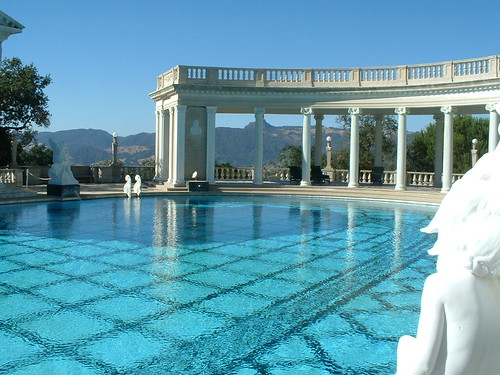Hearst Castle

Hearst Castle was the palatial estate of newspaper magnate William Randolph Hearst. It is located near San Simeon, California, on a hill overlooking the Pacific Ocean, halfway between Los Angeles and San Francisco. Donated by the Hearst Corporation to the state of California in 1957, it is now a State Historical Monument and a National Historic Landmark, open for public tours.

Hearst inherited the ranch, which had grown to 250,000 acres (1000 km²), from his mother, Phoebe Apperson Hearst, upon her death in 1919. San Francisco architect Julia Morgan designed most of the buildings.
The estate is a pastiche of historic architectural styles that Hearst admired in his travels around Europe. For example, the main house is modeled after a 16th century Spanish cathedral, while the outdoor pool features an ancient Roman temple front transported wholesale from Europe and reconstructed at the site.

Hearst furnished the estate with truckloads of art, antiques, and even whole ceilings that he acquired en masse from Europe and Egypt. Hearst Castle was like a small self-contained city, with 56 bedrooms, 61 bathrooms, 19 sitting rooms, 127 acres of gardens, indoor and outdoor swimming pools, tennis courts, a movie theater, an airfield, and the world’s largest private zoo. Zebras and other exotic animals still roam the grounds.

Some of the highlights of the estate include the Neptune Pool, which features an expansive vista of the mountains, ocean and the main house.
Invitations to Hearst Castle were highly coveted during its heyday in the 1920s and ’30s. The Hollywood and political elite often visited the ranch such as Charlie Chaplin, Cary Grant, the Marx Brothers, Charles Lindbergh, Joan Crawford, Calvin Coolidge, and Winston Churchill.
 Welcome to Cambria
Welcome to Cambria Photo Tour
Photo Tour Attractions
Attractions Recreation
Recreation Events Calendar
Events Calendar